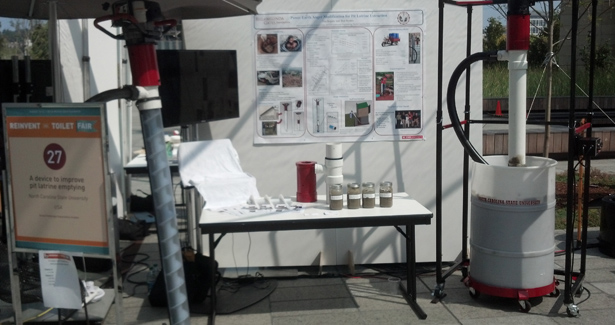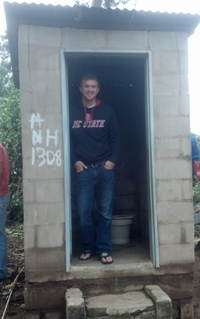Innovation to Save Lives: A Student’s Story, Part II

Editor’s Note: This is a guest post by NC State grad student Tate Rogers. Rogers came up with an idea to address the life-threatening challenge of human waste disposal in the developing world, and was part of a team that received funding from the Bill and Melinda Gates Foundation to pursue the idea further. Rogers presented the project to the foundation last August in Seattle, and also attended a waste management conference in South Africa, which taught him a lot about the sanitation challenges facing the developing world. He writes about those experiences here.
Earlier this year I traveled with Dr. Robert Borden, who helped inspire this project, to the Reinvent the Toilet Fair on the Bill and Melinda Gates Foundation campus in Seattle, a gathering of over 30 Gates Foundation-funded projects.
Eight of these projects were working on literally reinventing the toilet as we know it and the rest, such as ours, were looking at specific aspects of sanitation that needed improving in the developing world. Our project revolves around a very simple design and will hopefully be ready for field implementation in 2013. However, although very necessary, our project will serve as a “band aid” solution for the sanitation issues facing the developing world. There are still overarching problems that currently have the developing world decades behind in sanitation.
This is why projects such as the Caltech design, which uses a solar-powered electrochemical reactor to convert human waste to fertilizer and hydrogen, are important. I believe both types of projects are important. We need short-term solutions to address current problems in the developing world, but we should also be searching for answers that completely revolutionize how we think about sanitation. Our current system in first world countries uses a tremendous amount of water and piping infrastructure that requires massive amounts of time and money – commodities that aren’t necessarily available in the developing world. Also, the Gates Foundation, along with the sanitation community, is trying to change the stigma that surrounds human waste as something “nasty” that we just want to magically disappear into our toilets. Instead, human waste should be looked at as a valuable resource with many capabilities including fertilizer and energy.
Of the many interesting projects on display in Seattle, which you can find out more about at the Gates Foundation website, I would like to mention a couple of the technologies that caught my eye for different reasons.

First, the re-char team that is currently based in Kenya is providing low cost kilns made from a 55 gallon drum to local farmers. It acts as a waste disposal method through pyrolysis, which converts the waste to biochar by basically heating the waste to extreme temperatures. The biochar they produce can be used as wood charcoal or chemical fertilizers that rival the crop yields of local commercial fertilizers. It is a low-cost, simple design that has already shown success in Kenya.
Another project I want to mention is the Sanitation Ventures team. They are currently working on two designs: one that uses tiger worms in a biofilter to digest the waste and another that utilizes black soldier fly larvae. The black soldier fly larvae design is the most interesting to me because of the social aspect. The basic idea is that the larvae would digest the waste and are then harvested at their pre-pupae stage to be used for animal feed or biodiesel. While this is very intriguing from a scientific aspect, I wonder if you can make it socially acceptable for humans to be using the bathroom directly into a pile of larvae.
The Reinvent the Toilet Fair was also useful to us as we continue towards our goal of implementing our design in the developing world. We were able to meet and present to several scientists, engineers, NGO employees and investors. We received some great feedback on the simplicity and cost-effectiveness of the design. We also received some valuable feedback on some of the problems we may encounter in the field from people who have actually been on the ground in the developing world and dealing with pit latrine emptying first hand. So, from our time in Seattle we were able to 1) discover some helpful design modifications and 2) form relationships with several organizations that will allow us to move forward with field testing and implementation in the future.
Another exciting experience I have had since my last post was attending the 2nd Fecal Sludge Management Conference in Durban, South Africa, in October. Although I get some funny looks when I tell people the names of the conferences I have attended, I have had some amazing experiences at both of them.
For the conference in South Africa, I was accompanied by Dr. Francis de los Reyes, who is also working on the project. Our project was selected to present at the conference which focused on sludge management from the pit latrine to sludge disposal. This included pit latrine management, pit emptying, transporting waste, resource creation from sludge and urine, and waste disposal. The conference was relatively small, but the group of people who are working in the field of sanitation are incredibly smart, focused and passionate about their work. This is evident in the amount of progress that is currently being made in providing not only hygienic but sustainable sanitation to the developing world. The efforts of the involved organizations and people have brought a lot of attention to the previously overlooked subject of sanitation and the amount of resources, research and work being put into this subject is growing immensely.
This conference was also of great benefit to our project. We were able to speak with people who have developed and tested several pit latrine emptying devices. We also became more informed about the systems that are currently in place to actually empty the latrines, transport and dispose of the waste, and finance and organize the operation. The greatest experience of this trip, however, was the field trip on the final day. We were able to visit a couple of different latrines and watched them be emptied with different mechanisms.. While watching sludge get pumped from pits may not sound like the most fun way to spend a day in Africa, it allowed us to finally see the conditions where our machine will eventually be used. In addition, we were able to see and meet some of the people that our technology would ultimately benefit, which is a great inspiration as we move forward.
The take home message from this trip was that no two pits were the same. Every pit could have different configurations, distances from the closest road, waste characteristics, amounts of trash in the pits, systems in place for emptying and disposal, etc. This means that our pit emptying device needs to be adaptable to as many situations as possible in order for it to be a viable solution in the developing world.
We are currently making design changes to the existing prototype in addition to providing a slightly different option that will provide the users with choices when selecting a pit emptying technology that meets their price range and needs. We are planning on returning to South Africa in February to field test our designs on an array of pit latrines through collaboration with local organizations. After that we will be applying for a Phase II grant from the Bill and Melinda Gates Foundation, in which we would try to implement this technology in several locations throughout the developing world.
- Categories:


